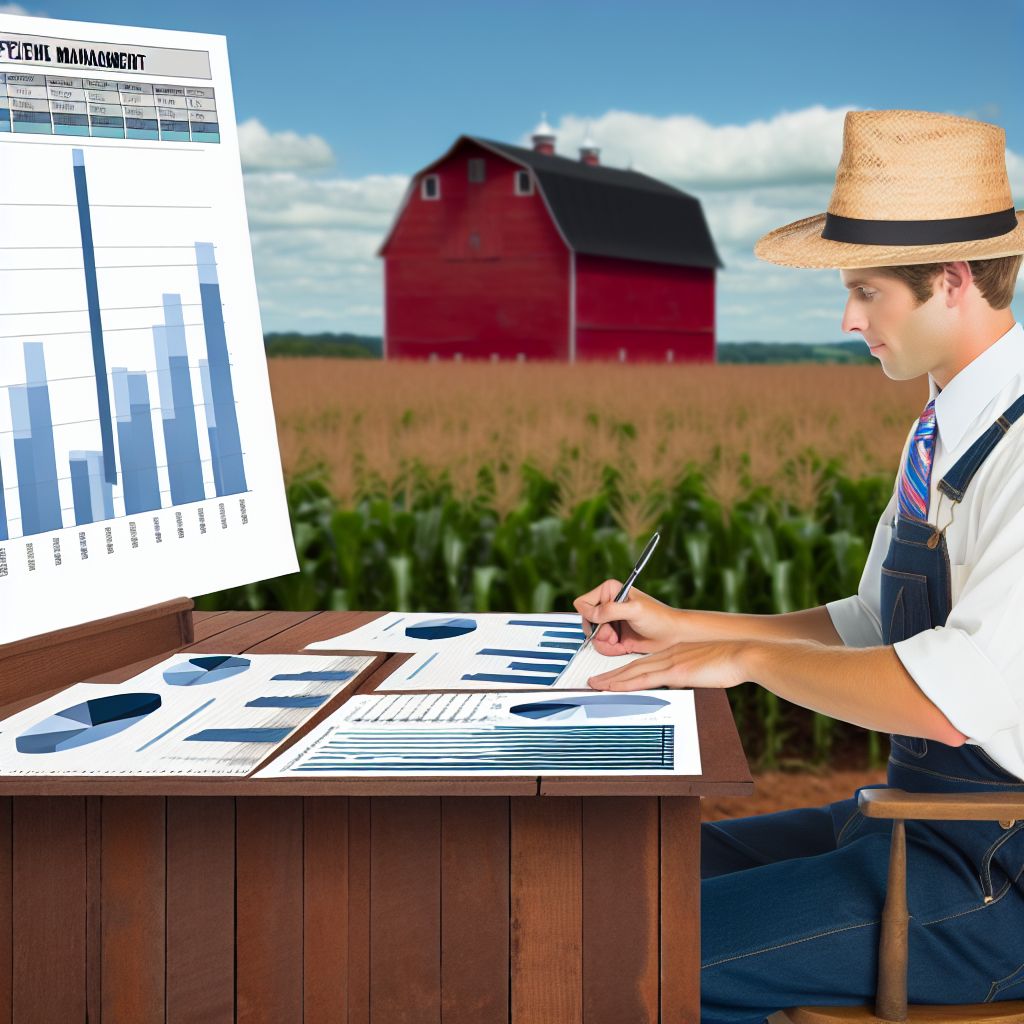Introduction to Farm Financial Management
Farm financial management plays a crucial role in agricultural success.
Farmers can maximize their profits by utilizing effective financial practices.
Understanding financial management helps in informed decision-making.
This section explores key concepts and strategies.
The Importance of Financial Management
Effective financial management enhances farm productivity.
It provides control over expenses and revenues.
Moreover, it helps in predicting cash flow needs.
Ultimately, sound financial planning increases profitability.
Key Components of Financial Management
Farm financial management consists of several critical components.
- Budgeting ensures farmers allocate resources efficiently.
- Record-keeping helps track expenses and income.
- Financial statements provide insights into overall performance.
- Risk management strategies mitigate potential financial losses.
These components work together to support robust financial health.
Understanding Budgets
Budgets are essential tools for any farming operation.
They help in planning and controlling financial resources.
Farmers should regularly review and adjust their budgets.
Effective budgeting leads to better financial outcomes.
The Role of Record-Keeping
Accurate record-keeping lays the foundation for financial management.
Transform Your Agribusiness
Unlock your farm's potential with expert advice tailored to your needs. Get actionable steps that drive real results.
Get StartedFarmers should maintain up-to-date records of all transactions.
This practice aids in identifying trends and making informed decisions.
Additionally, it simplifies the tax preparation process.
Analyzing Financial Statements
Financial statements reveal vital information about a farm’s performance.
Farmers should familiarize themselves with key statements.
- The income statement shows profitability over a period.
- The balance sheet reflects the farm’s financial position.
- The cash flow statement outlines cash inflows and outflows.
Regular analysis of these statements helps guide strategic decisions.
Implementing Risk Management Strategies
Managing financial risk is critical for farm sustainability.
Farmers can utilize various strategies to mitigate these risks.
Diverse crop and livestock production can reduce dependency on one market.
Additionally, farmers should consider insurance options for protection.
These precautions ensure stability in uncertain times.
Understanding Farm Income and Expenses
Overview of Farm Income
Farm income primarily comes from the sale of crops and livestock.
It may also include government payments, grants, and subsidies.
Maintaining accurate records is crucial for tracking income effectively.
Additionally, diverse income streams can enhance farm resilience.
Types of Income Sources
Sales from crops form the backbone of farm income.
Livestock sales contribute significantly as well.
Value-added products increase revenue potential.
Moreover, agritourism can provide a welcome boost to finances.
Understanding Farm Expenses
Farm expenses encompass all costs incurred during operations.
These include inputs such as seeds, fertilizers, and fuel.
Labor costs are another significant factor in expense calculations.
Regular maintenance of machinery also impacts overall costs.
Categorizing Farm Expenses
Fixed expenses remain constant regardless of production levels.
Showcase Your Farming Business
Publish your professional farming services profile on our blog for a one-time fee of $200 and reach a dedicated audience of farmers and agribusiness owners.
Publish Your ProfileExamples include rent, mortgages, and insurance premiums.
Variable expenses fluctuate with production, such as feed and seeds.
Furthermore, unexpected costs can arise, impacting profit margins.
Strategies for Income and Expense Management
Monitoring cash flow regularly ensures financial stability.
Creating a detailed budget aids in expense management.
Utilizing financial software can streamline record-keeping efforts.
Additionally, conducting periodic financial reviews allows for informed decision-making.
The Role of Financial Analysis
Financial analysis provides insight into farm profitability.
Assessing key performance indicators helps identify areas for improvement.
Furthermore, comparing performance against benchmarks offers valuable context.
Ultimately, informed decisions can lead to enhanced profitability.
Leveraging Technology for Financial Management
Technology plays a vital role in modern farm financial management.
Farm management software enables better tracking of income and expenses.
Mobile applications can provide real-time data access.
Using data analytics can reveal trends that aid in planning.
Assessing the Financial Health of Your Farm
Understanding Financial Statements
Financial statements provide crucial insights into your farm’s performance.
They typically include the income statement, balance sheet, and cash flow statement.
Each statement reveals different aspects of financial health.
Start by reviewing the income statement for profitability.
This statement shows revenues and expenses over a specific period.
Next, examine the balance sheet to view assets and liabilities.
This sheet reflects what your farm owns and owes at a specific date.
Lastly, analyze the cash flow statement to understand liquidity.
This document helps track cash coming in and going out over time.
Key Performance Indicators
Identify key performance indicators (KPIs) to monitor efficiency.
Common KPIs for farms include gross margin, net profit margin, and return on assets.
Gross margin indicates the difference between revenue and cost of goods sold.
Net profit margin reflects the remaining profit after expenses are deducted.
Return on assets shows how effectively the farm utilizes its assets.
Regularly calculating these metrics reveals trends over time.
Additionally, benchmarks against industry standards provide valuable context.
Budgeting and Forecasting
Create a comprehensive budget to manage financial resources effectively.
A budget outlines expected revenues and planned expenses for the year.
Use historical data to make accurate forecasts.
Regularly compare actual performance against the budget.
This practice allows for timely adjustments in spending and operations.
Consider scenario planning to prepare for uncertainties.
This method helps assess potential impacts of various conditions on finances.
Financial Analysis Tools
Employ financial analysis tools to enhance decision-making.
Popular tools include spreadsheets, accounting software, and farm management apps.
Showcase Your Farming Business
Publish your professional farming services profile on our blog for a one-time fee of $200 and reach a dedicated audience of farmers and agribusiness owners.
Publish Your ProfileSpreadsheets allow for custom calculations and scenario modeling.
Accounting software streamlines financial recording and reporting tasks.
Farm management apps assist with tracking production and expenses.
Adopting these tools increases accuracy and saves time.
Consulting Professionals
Consider consulting financial professionals for expert advice.
Accountants can help optimize tax strategies and compliance.
Financial advisors offer insights into investment opportunities and risk management.
Leveraging their expertise aids in implementing sound financial practices.
Moreover, attending financial management workshops enhances your knowledge.
Stay informed about best practices and industry trends.
See Related Content: Integrating Precision Agriculture for Sustainable Farm Management
Budgeting Techniques for Farmers: Best Practices
Setting Clear Financial Goals
Farmers should define their financial objectives clearly.
These objectives help create a focused budget.
Consider both short-term and long-term goals.
Prioritize goals that align with overall farm strategy.
Creating a Comprehensive Budget
A comprehensive budget includes all revenue and expenses.
Outline fixed and variable costs for accuracy.
Include costs for feed, seeds, labor, and equipment.
Incorporate potential income from crop sales.
Utilizing Technology for Budgeting
Leverage budgeting software to streamline the process.
Such technology offers user-friendly interfaces and analytics.
Software like QuickBooks simplifies financial tracking.
Consider apps specifically designed for farmers.
Monitoring and Adjusting the Budget
Regularly review the budget for necessary adjustments.
Track actual spending against the budgeted amounts.
Identify areas where expenses exceed estimates.
Make timely adjustments to avoid financial strain.
Engaging in Financial Education
Educate yourself about farm financial management.
Consider workshops and online courses in budgeting.
Networking with other farmers can provide insights.
Stay informed on market trends that impact budgeting.
Delve into the Subject: Renewable Energy Solutions for Diversified Farms
Utilizing Technology for Efficient Financial Tracking
Adopting Financial Management Software
Farmers can greatly benefit from financial management software.
This software enables easy tracking of income and expenses.
Additionally, it provides real-time insights into financial health.
Many options are available, like QuickBooks and FarmBooks.
Choosing the right tool will streamline your financial processes.
Implementing Mobile Applications
Mobile applications make financial tracking convenient.
Farmers can log transactions immediately using their smartphones.
This immediate logging reduces the risk of errors later.
Showcase Your Farming Business
Publish your professional farming services profile on our blog for a one-time fee of $200 and reach a dedicated audience of farmers and agribusiness owners.
Publish Your ProfileSome apps even sync with your bank accounts for added efficiency.
Applications like Expensify and Mint are excellent choices.
Using Cloud Storage for Document Management
Cloud storage is an essential tool for managing financial documents.
It allows easy access to important files from anywhere.
Organizing receipts and invoices becomes hassle-free with cloud storage.
Options like Google Drive or Dropbox can keep your documents secure.
In turn, this organization leads to easier tax preparation.
Incorporating Budgeting Tools
Budgeting tools help in planning your farm’s financial future.
These tools allow you to set goals and allocate resources efficiently.
Many budgeting tools come with forecasting features.
These forecasts support informed decision-making.
Programs like YNAB (You Need A Budget) are worth considering.
Analyzing Financial Data with Analytics Software
Analytics software helps in interpreting financial data effectively.
This software can identify trends and areas for improvement.
Utilizing dashboards allows quick visual insights into your finances.
Tools like Tableau or Microsoft Power BI offer powerful analytics capabilities.
By regularly analyzing your data, you can maximize your profits.
Explore Further: Eco-Friendly Pest Management Strategies for Sustainable Farms
Cost Reduction Strategies in Farming Operations
Assessing Current Expenses
Begin by evaluating your existing costs thoroughly.
Identify all fixed and variable expenses in your operation.
This assessment helps in pinpointing areas for potential savings.
Moreover, involve your financial advisor in this analysis.
Streamlining Supply Chain Management
Optimize your supply chain for maximum efficiency.
Establish relationships with local suppliers to reduce shipping costs.
Consider bulk purchasing agreements for essential materials.
Additionally, implement an inventory management system.
This system helps you track supplies in real time.
Implementing Sustainable Practices
Invest in sustainable farming methods to lower long-term costs.
For instance, rotating crops can enhance soil fertility.
Solar panels can also reduce energy expenses significantly.
Furthermore, utilizing rainwater harvesting systems minimizes water costs.
Utilizing Technology for Efficiency
Embrace technology to enhance productivity and reduce waste.
Precision agriculture tools can optimize input use effectively.
GPS-guided equipment can reduce fuel and labor expenses.
Consider software that assists in financial planning and forecasting.
Employee Training and Management
Invest in training programs for your workforce.
Knowledgeable employees perform tasks more efficiently.
Additionally, cross-train staff to cover overlapping duties.
This practice can reduce overtime costs significantly.
Regularly Review Financial Performance
Establish a routine to review your financial statements.
Showcase Your Farming Business
Publish your professional farming services profile on our blog for a one-time fee of $200 and reach a dedicated audience of farmers and agribusiness owners.
Publish Your ProfileLook for trends in expenses and identify anomalies swiftly.
Use benchmarking against industry standards to assess performance.
Therefore, adjust your strategies based on this analysis.
Utilizing Government Programs and Grants
Research available government grants and aid programs.
Many programs offer funding for sustainable practices.
Stay informed about local agricultural grants to relieve costs.
This financial assistance can make a significant difference.
You Might Also Like: Utilizing Drones For Precision Farming Applications

Implementing Sustainable Practices for Long-term Profitability
Understanding Sustainable Financial Management
Sustainable financial management is crucial for farm profitability.
This approach enhances resilience to market fluctuations.
It focuses on long-term investment in environmentally-friendly practices.
Identifying Cost-effective Sustainable Practices
Farmers should evaluate their current practices for sustainability.
Crop rotation can improve soil health and yield.
Cover crops play a vital role in preventing soil erosion.
Integrating livestock and crop production enhances nutrient cycling.
Investing in renewable energy options can lower operating costs.
Leveraging Technology for Efficiency
Technology significantly enhances sustainable farm management.
Precision agriculture helps in resource optimization.
Data analytics can forecast crop yields and manage risks.
Farm management software simplifies financial tracking.
Engaging in Sustainable Market Practices
Farmers should explore local markets for their products.
Community-supported agriculture broadens customer reach.
Direct sales increase profits by cutting out intermediaries.
Participating in sustainable certification programs builds consumer trust.
Monitoring and Evaluating Practices
Regular assessment of sustainable practices is essential.
Farmers should track environmental impacts and financial outcomes.
Adjusting practices based on evaluations improves sustainability.
Ongoing education helps farmers stay updated on best practices.
Analyzing and Diversifying Revenue Streams
The Importance of Revenue Diversification
Diversifying revenue streams can enhance financial stability for farmers.
This approach reduces dependence on a single source of income.
Moreover, it mitigates risks associated with market fluctuations.
By exploring various income avenues, farmers can adapt to changing conditions.
Identifying Potential Revenue Sources
Farmers should start by analyzing their current operations.
Identifying successful crops or livestock can provide insights.
Additionally, examining local market demands can unveil opportunities.
Farmers can consider value-added products for enhanced profitability.
Examples of Value-Added Products
- Homemade jams and jellies made from excess fruit
- Artisan cheese crafted from surplus milk
- Frozen vegetables or pre-packaged meal kits
- Organic fertilizers produced from composting
Exploring Alternative Revenue Streams
In addition to traditional farming, consider alternative ventures.
Agritourism has gained popularity and can attract visitors.
Hosting farm tours, workshops, or seasonal events can generate income.
Renting land for events or initiatives can also be profitable.
Showcase Your Farming Business
Publish your professional farming services profile on our blog for a one-time fee of $200 and reach a dedicated audience of farmers and agribusiness owners.
Publish Your ProfileLeveraging Digital Platforms
Farmers can use online marketplaces to sell products directly.
Social media can help promote farmers and their offerings.
Implementing e-commerce strategies can reach larger audiences.
Strategic Planning and Analysis
Developing a detailed plan can guide diversification efforts.
This plan should include market research and feasibility studies.
Establishing goals and timelines ensures accountability.
Regularly reviewing progress and adjusting strategies is essential.
The Role of Financial Advisors in Agricultural Management
Understanding Financial Advisors’ Impact
Financial advisors play a crucial role in agricultural management.
They offer specialized knowledge tailored to farming operations.
Advisors help farmers make sound financial decisions.
As a result, they enhance overall profitability and sustainability.
Key Responsibilities of Financial Advisors
Financial advisors assist in developing comprehensive financial plans.
They analyze income statements and cash flow projections.
This thorough assessment helps identify potential issues early.
Additionally, they offer investment strategies tailored to agriculture.
Such strategies can optimize returns on farming assets.
Benefits of Engaging with Financial Advisors
Engaging with financial advisors can reduce financial stress for farmers.
Moreover, they provide access to valuable resources and tools.
These tools streamline financial management tasks.
Furthermore, financial advisors help farmers navigate complex regulations.
This knowledge is essential for maintaining compliance.
Tailored Financial Strategies for Agricultural Practices
Financial advisors create personalized strategies based on unique needs.
These strategies often include budgeting and cost management techniques.
They also focus on optimizing production costs effectively.
Consequently, farmers can allocate resources more efficiently.
Choosing the Right Financial Advisor
Selecting a qualified financial advisor is pivotal for success.
Farmers should consider experience and expertise in agriculture.
Additionally, compatibility with farming operations is essential.
Working with an advisor who understands local market conditions is advantageous.
Ultimately, the right advisor can significantly impact long-term profitability.
Case Studies: Successful Financial Management in Farming
Introduction to Financial Management in Farming
Effective financial management is crucial for farmers.
It enables them to optimize resources and maximize profits.
Recent case studies illustrate successful financial strategies.
Case Study: Green Valley Farms
Green Valley Farms demonstrates efficient record-keeping practices.
They use digital tools to track all income and expenses.
This clarity aids in identifying profitable areas.
Additionally, they conduct monthly financial reviews.
These reviews help in making informed decisions quickly.
Profit Optimization Techniques
Green Valley Farms applied precision farming techniques.
This method maximized crop yields while minimizing costs.
Showcase Your Farming Business
Publish your professional farming services profile on our blog for a one-time fee of $200 and reach a dedicated audience of farmers and agribusiness owners.
Publish Your ProfileThey also diversified their crops to reduce risks.
This strategy enhanced their market reach and stability.
Case Study: Sunny Plains Dairy
Sunny Plains Dairy showcases the importance of budgeting.
They prepare annual budgets to forecast revenues and expenses.
This helps in identifying potential cash flow issues early.
They regularly adjust their budgets based on actual performance.
Risk Management Strategies
Sunny Plains Dairy employs hedging strategies to manage price fluctuations.
This approach protects them against market volatility.
In addition, they have insurance to cover unexpected losses.
These risk management practices ensure financial stability.
Case Study: Riverside Orchards
Riverside Orchards focuses on cost reduction techniques.
They implemented energy-efficient systems across operations.
This initiative significantly reduced their overhead costs.
They also negotiate bulk purchasing agreements with suppliers.
Supplier Relationship Enhancements
Building strong relationships with suppliers has paid off.
Riverside Orchards receives better pricing through loyalty.
They continually seek alternative suppliers to ensure competitive rates.
Such strategies enhance their profit margins effectively.
Lessons Learned Across Case Studies
Each case exemplifies the value of financial management.
All farmers benefit from leveraging technology for decision-making.
Building relationships with suppliers and customers yields dividends.
Effective risk management is critical for sustainability in farming.
Additional Resources
Maximizing Production in Small-Scale Flower Farming: Tips for …




